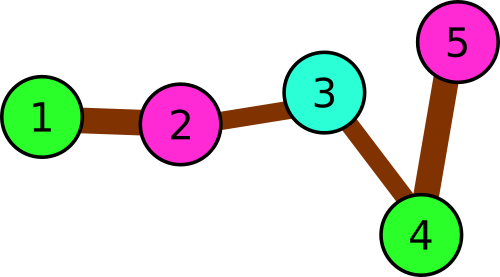C. Andryusha and Colored Balloons
time limit per test
2 seconds
memory limit per test
256 megabytes
input
standard input
output
standard output
Andryusha goes through a park each day. The squares and paths between them look boring to Andryusha, so he decided to decorate them.
The park consists of n squares connected with (n - 1) bidirectional paths in such a way that any square is reachable from any other using these paths. Andryusha decided to hang a colored balloon at each of the squares. The baloons' colors are described by positive integers, starting from 1. In order to make the park varicolored, Andryusha wants to choose the colors in a special way. More precisely, he wants to use such colors that if a, b and c are distinct squares that a and b have a direct path between them, and b and c have a direct path between them, then balloon colors on these three squares are distinct.
Andryusha wants to use as little different colors as possible. Help him to choose the colors!
Input
The first line contains single integer n (3 ≤ n ≤ 2·105) — the number of squares in the park.
Each of the next (n - 1) lines contains two integers x and y (1 ≤ x, y ≤ n) — the indices of two squares directly connected by a path.
It is guaranteed that any square is reachable from any other using the paths.
Output
In the first line print single integer k — the minimum number of colors Andryusha has to use.
In the second line print n integers, the i-th of them should be equal to the balloon color on the i-th square. Each of these numbers should be within range from 1 to k.
Examples
Input
3
2 3
1 3
Output
3
1 3 2
Input
5
2 3
5 3
4 3
1 3
Output
5
1 3 2 5 4
Input
5
2 1
3 2
4 3
5 4
Output
3
1 2 3 1 2
Note
In the first sample the park consists of three squares: 1 → 3 → 2. Thus, the balloon colors have to be distinct.
 Illustration for the first sample.
Illustration for the first sample.
In the second example there are following triples of consequently connected squares:
- 1 → 3 → 2
- 1 → 3 → 4
- 1 → 3 → 5
- 2 → 3 → 4
- 2 → 3 → 5
- 4 → 3 → 5
 Illustration for the second sample.
Illustration for the second sample.
In the third example there are following triples:
- 1 → 2 → 3
- 2 → 3 → 4
- 3 → 4 → 5
 Illustration for the third sample.
Illustration for the third sample.
题意:
给你一个图,给所有节点染上颜色,要求是相邻的三个节点的颜色不能相同,求需要的最少的颜色数
思路:
为了方便叙述,我们给颜色编号,从1开始,不一样的序号代表不一样的颜色,序号最大者即为需要的颜色种数
首先,由题目上的条件,这个图一定是一棵树,因为是一颗树,我们可以从任一节点开始,DFS遍历完所有节点。
结合图为树的条件,经过分析得到,要使每相邻三个节点的颜色不同,
只需满足两个条件:
1.使这个节点和他的兄弟节点颜色不同
2.使这个节点和它的的父亲节点及爷爷节点颜色不同
为了满足这两个条件,并使得颜色数最少,我们在DFS到一个节点时,遍历他所有的子节点,都染上颜色,颜色序号在满足以上条件时要尽可能的小